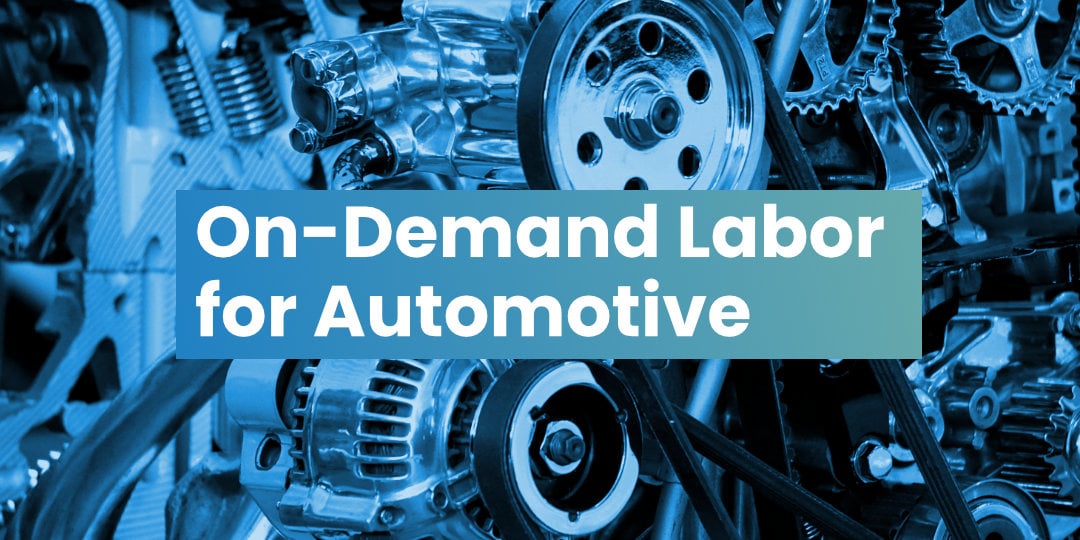On-Demand Labor for Automotive Manufacturers
Automotive manufacturing is not immune to the challenges facing the rest of the supply chain. Volatility is common in manufacturing and certain variables, such as geopolitical uncertainty, are often out of the circle of control. However, two of the most common struggles which can be affected are labor and the supply chain. If you sample a group of manufacturers, those two topics will come up over and over.
When I changed careers to work in automotive, I worked at a Tier 1 hydroformer and then a Tier 2 precision parts manufacturer. I learned that things can and will go wrong, but how you handle it is the key to success.
Now, I work with Veryable to introduce the on-demand labor model to companies so they can build flexible capacity to solve the types of automotive problems described above.
In this article, you’ll learn how on-demand labor can help you solve common automotive manufacturing challenges.
Major Automotive Manufacturing Problems to Address
In automotive, programs are awarded and last several years before entering service. Releases are issued at a set interval, but building to releases can only do so much when it comes to capacity planning. Disruptions in the supply chain or changes to a program can throw plans out the window.
Programs get delayed, the production part approval process (PPAP) drags things out, timelines get changed, delays in material push out delivery, scrap is higher than expected, IATF/ISO standards audits pull valuable resources off their core tasks, costs are higher than quoted, the print for a part simply is not feasible, prototypes are not in spec, releases do not fully materialize, and the list goes on.
It all comes down to something a mentor of mine used to tell me: “At the end of the day, if someone doesn’t put a part in a box, none of us get paid.”
You must be flexible and able to adapt to thrive, or survive, in the current marketplace.
How On-Demand Labor Helps Reach Full Utilization
Any line not being fully utilized is losing money. The last thing any supplier wants to do is risk shutting down an OEM. You could be looking at a hefty fine of $140k-$300k per hour if you did. I have never actually seen the fines be charged firsthand; rather, the concern itself is simply known. The greater risk is being desourced or losing the ability to quote the next program. Lines and facilities are built to service certain programs, and it can take months or years to win other programs.
Short shipping products can lead to supply chain disruptions and mess up capacity planning. Overtime (OT) can be utilized to try to catch up, but there’s only so much one can do in a day. If a part needs to be on the truck at 5pm, you’re limited by capacity and risk shutting down a line or incur costly expediting costs. There have been times in the past where I personally had to run parts in my own car to keep production going.
December 2021 was a hectic month for suppliers, but it showed me an example of how on-demand labor can make a dramatic difference in a business. A Tier 1 supplier using Veryable’s on-demand labor platform in the Detroit area created around one million dollars of value in the month by keeping their labor capacity exactly at the exact level they needed.
Demand was continuously shifting and the business needed to respond accordingly. As releases increased, the supplier was able to flex up with on-demand labor to ensure product was being delivered on time and quality maintained. As releases decreased, the company flexed down to keep efficiency where it needed to be and cut back on fixed costs. This greatly reduced its OT and turnover, and kept it from going toward a potential, costly shutdown.
How On-Demand Labor Creates Downcycle Agility
Chip shortages are a common issue during these times, and they’re difficult to plan around. Suppliers are throttled, or down, and then a shipment comes in and it’s time to move. This start-stop nature has a negative impact on the industry because it is costly. Machines are left idle and the workforce is terminated or underutilized.
Overstaffing to protect against this has become more common, but this adds an extra fixed cost to a supplier.
Having an ability to directly respond in real time provides a competitive advantage. Creating a flexible labor pool through on-demand labor allows suppliers to perfectly match production as needed without incurring the fixed cost. This provides a level of downcycle agility not possible in the traditional sense.
With On-Demand Labor, costs are only incurred during use and there is no fixed rate outside of usage. Labor Intelligence allows a supplier to plug in their throughput and headcount to determine if a line (or facility) is under/overutilized.
How On-Demand Labor Helps Control Unit Costs
Pulling all this together provides greater agility through a more cost-effective, leaner operation and allows for more responsiveness within the supply chain. A Tier 1 supplier has more visibility and liability but can quickly respond to changes in the marketplace.
This transparency diminishes as you reach the lower tiers, though. The inability to adapt to shifting releases directly impacts fixed costs in the form of a fully burdened full-time employee (FTE), directly impacting margins on each unit produced.
During a downcycle phase, an underutilized, less efficient FTE will negatively impact labor costs. If costs get out of hand, the conventional method is to review the potential of achieving a piece price increase. This is one of the last actions any supplier wants to take as doing so will most likely put future business at risk.
This is especially critical in situations where a typical 3x3 LTA (long term agreement) is in place. Revenue and profitability per piece will decrease over a three-year period. If efficiency is not gained, margins will quickly start to erode.
Flexing capacity with on-demand labor allows unit cost to be held flat, or improved upon in comparison to quoted margins, by perfectly adjusting capacity to meet updated production numbers.
Real World Example
ADAC Automotive, one of the leading automotive parts suppliers in the industry, faced a pivotal challenge - predicting staff requirements to meet the fluctuating demands of their diverse clientele, which includes giants like Ford, Stellantis, General Motors, Honda, Nissan, Volkswagen, and BMW. The unpredictable nature of the industry made it almost impossible to accurately forecast labor needs on a weekly, monthly, or yearly basis, and consistently being over and under-staffed often led to increased overhead costs and missed delivery deadlines.
Building a dynamic labor pool and leveraging the platform at 3 different manufacturing plants in various work areas gave ADAC's operations leaders the ability to bring in additional support when needed, avoiding unnecessary overtime costs, and improving staff retention by preventing burnout from continuous long-hour shifts. Furthermore, the platform's advanced tagging and filter system has enabled ADAC to quickly identify and choose individuals with specific skills or prior experience in certain departments.
Read the Full Case Study
Conclusion
Every supplier wants to be an industry leader. You see it tacked onto most supplier sites/portals as a signal to customers that a supplier means business.
To truly achieve this, suppliers need greater speed and agility. On-demand labor allows for perfect order fulfillment and best-in-class lead times. This, in turn, allows a business to maintain minimal OT and hold unit cost flat to provide a competitive advantage. This allows a supplier to pick the businesses and margins they need to win.
To start controlling your unit costs, gain downcycle agility, and reach full utilization, you will need flexible capacity. You can start building flexible capacity today with Veryable’s on-demand labor platform by creating a free business profile.
To learn more about why OEM’s, Tier 1, and Tier 2 suppliers across the country are leveraging on-demand labor, and why it’s our fastest growing industry segment, visit our homepage for on-demand labor and the automotive industry:
Previous Posts
Why Your Operation Isn’t Too Complex or Specialized for On-Demand Labor
The Future of Manufacturing and Logistics
Create a free business profile today to explore our platform.






